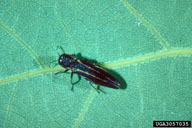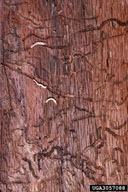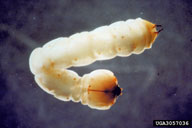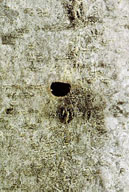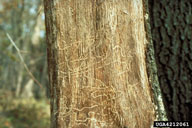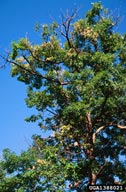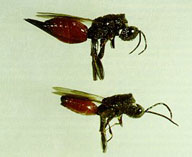Twolined chestnut borer
Agrilus bilineatus (Weber) (Coleoptera: Buprestidae)
Orientation to pest
Twolined chestnut borer, Agrilus bilineatus (Weber), is native to North America and occurs throughout southeastern Canada and the eastern and central United States. Adults are recognizable as dark colored buprestids with two golden stripes running lengthwise along their back. Adult beetles fly from April to August, depending on the location and there is one generation per year. In Michigan and surrounding areas, adult emergence peaks in mid-to late June. Females lay eggs in small clusters in bark cracks and crevices. Newly hatched larvae burrow into the tree and form feeding galleries under the bark. Larvae are light colored and up to 2.5 cm long when mature, and have two spines at the tip of the abdomen, as is typical for all Agrilus larvae. Larvae construct meandering galleries that are packed tightly with feces mixed with boring dust. These feeding galleries interrupt the transport of food and water in the phloem (inner bark) and xylem (outer sapwood) and eventually girdle individual branches or the entire tree. Attacks occur in stressed or dying chestnut (Castanea dentata [Marsh.] Borkh.) or oak (Quercus). Live healthy trees are typically not infested. Attacks usually begin in the crown of the tree, with some branches dying in the first year. Infestations progress downward, and the trees usually die in the second or third year. Incidence of attack by twolined chestnut borer increases following stress such as drought or defoliation from insects such as gypsy moth (Lymantria dispar [L.]).
Hosts commonly attacked
American chestnut (C. dentata) and various species of oak, especially white (Quercus alba L.), scarlet (Quercus coccinea Muenchh.), northern pin (Quercus ellipsoidalis E. J Hill), bur (Quercus macrocarpa Michx.), chestnut (Quercus prinus L.), northern red (Quercus rubra L.), post (Quercus stellata Wangenh.), black (Quercus velutina Lamb.), and live (Quercus virginiana Miller) oaks are hosts of twolined chestnut borer.
Distribution
Twolined chestnut borer is widespread in the eastern and central United States and southeastern Canada
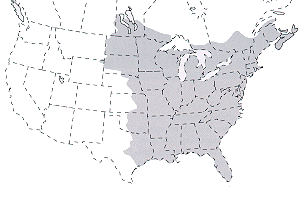 USDA Forest Service • Forest Insect and Disease Leaflet 168 USDA Forest Service • Forest Insect and Disease Leaflet 168 |
| Figure 1. Probable range of the twolined chestnut borer based on the combined distribution of its oak host species |
Images of twolined chestnut borer
| Figure 2. Adult of twolined chestnut borer, Agrilus bilineatus, showing the two golden stripes along the back | Figure 3. Larvae of twolined chestnut borer in galleries (left) and close up of larva (right), showing the two projections from the rear end of the body (found in all Agrilus species) | |
| Figure 4. The exit hole of the twolined chestnut borer, like that of other species of Agrilus, is D shaped rather than round or oval | Figure 5. View of the long winding larval galleries of twolined chestnut borer | Figure 6. The earliest signs of twolined chestnut borer attack are wilting of foliage in later summer and then death of upper limbs of tree | Figure 7. Phasgonophora sulcata is a common larval parasite of the twolined chestnut borer in Wisconsin |
Important biological control agents related to this pest species
Larval parasites provide limited natural control of the twolined chestnut borer. One larval parasite, the chalcid wasp Phasgonophora sulcata Westwood, causes up to 10% larval mortality.
Web links for information on twolined chestnut borer
Articles
- Dunbar, D. M. and G. R. Stephens. 1976. The bionomics of the twolined chestnut borer, pp. 73-83. In: Anderson, J. F. and H. K. Kaya (eds.) Perspectives in Forest Entomology. New York, New York. Academic Press.
- Cote, W. A., III and D. C. Allen. 1980. Biology of twolined chestnut borer, Agrilus bilineatus, in Pennsylvania and New York. Annals of the Entomological Society of America 73: 409-413.
- Haack, R. A., D. M. Benjamin, and B. A. Schuh. 1981. Observations on the biology of Phasgonophora sulcata (Hymenoptera: Chalcididae), a larval parasitoid of the twolined chestnut borer, Agrilus bilineatus (Coleoptera: Buprestidae), in Wisconsin. The Great Lakes Entomologist 14: 113-116.
- Haack, R. A. and D. M. Benjamin. 1982. The biology and ecology of the twolined chestnut borer, Agrilus bilineatus (Coleoptera: Buprestidae), on oaks, Quercus spp., in Wisconsin. The Canadian Entomologist 114: 385-396.
- Dunn, J. P., T. W. Kimmerer, and G. L. Nordin. 1986. The role of host tree condition in attack of white oaks by the twolined chestnut borer, Agrilus bilineatus (Weber) (Coleoptera: Buprestidae). Oecologia 70: 596-600.
- Muzika, R. M., A. M. Liebhold, and M. J. Twery. 2000. Dynamics of twolined chestnut borer, Agrilus bilineatus, as influenced by defoliation and selection thinning. Agricultural and Forest Entomology 2: 283-289. (available at http://onlinelibrary.wiley.com/doi/10.1046/j.1461-9563.2000.00077.x/pdf)
